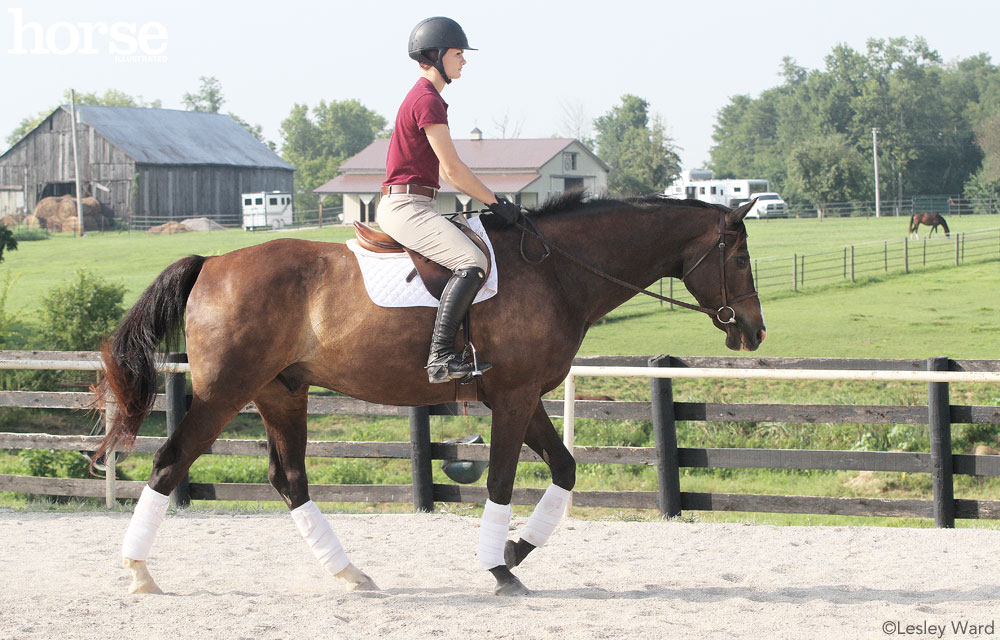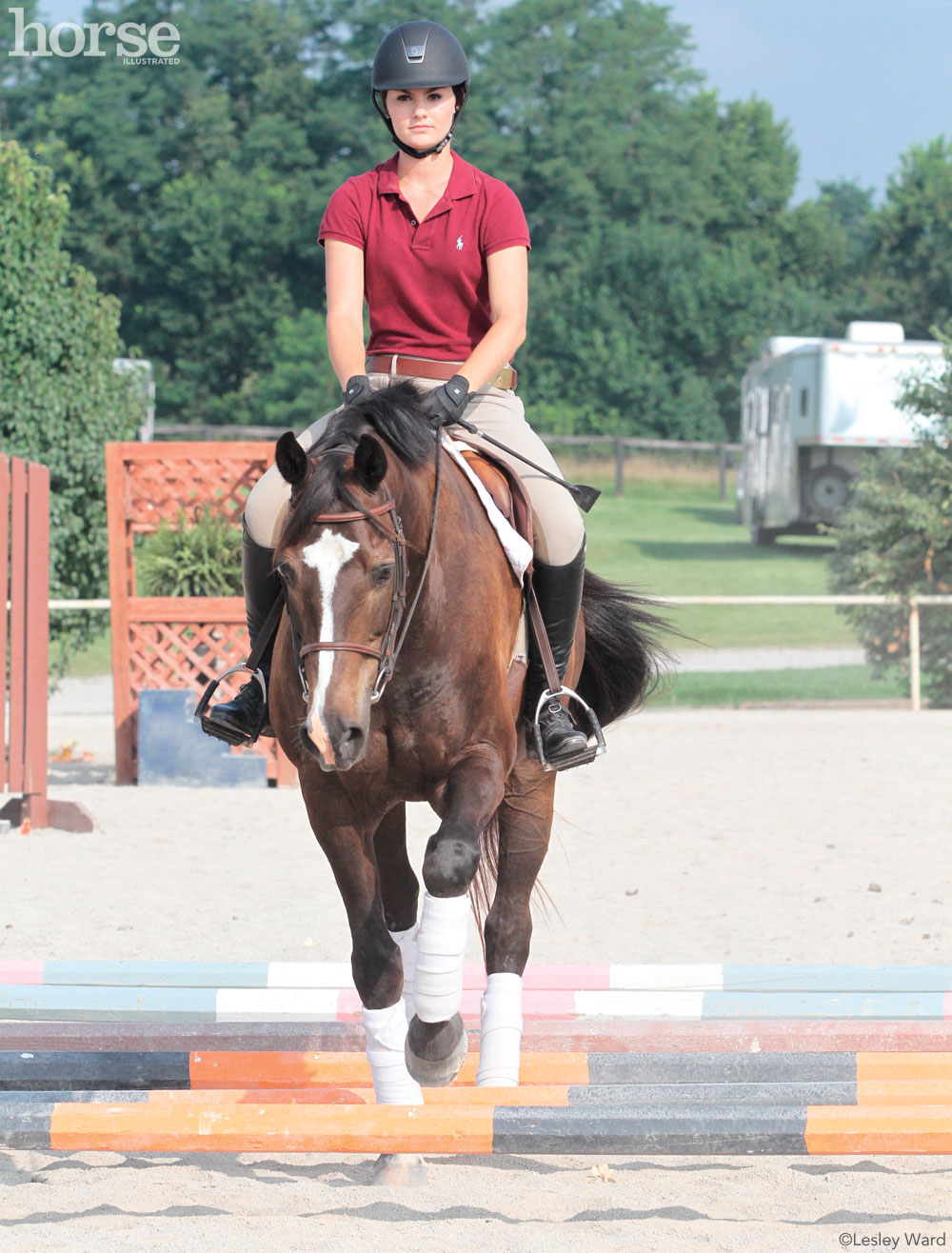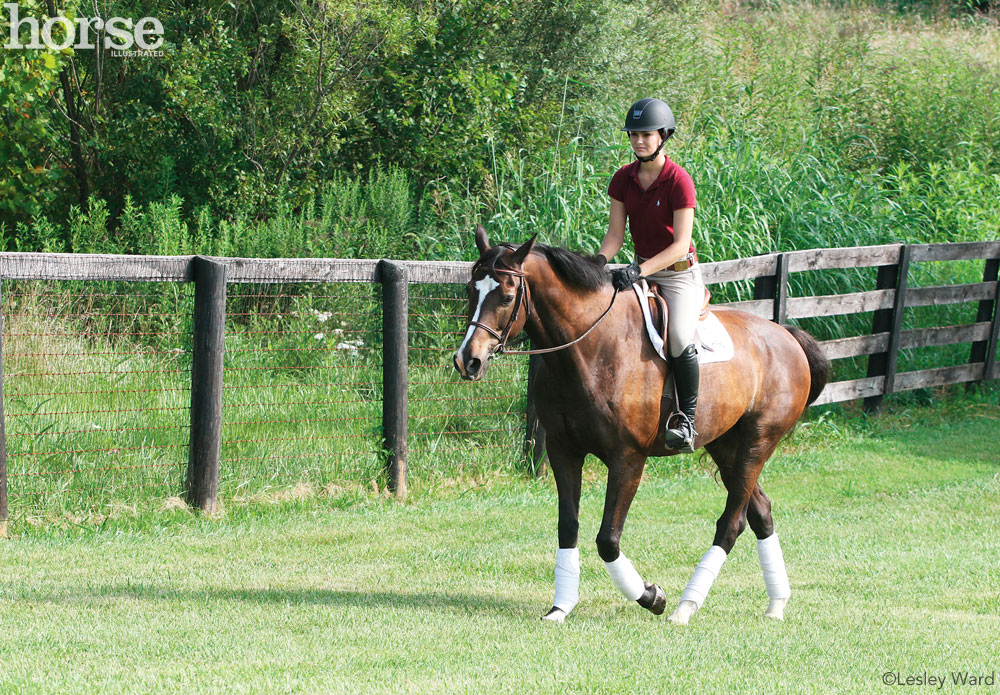
Loosening Up
The first rule of warming up is to emphasize circulation and joint mobility, and only then progress to a livelier phase of riding.
When you mount up or begin longeing, you should spend three to five minutes allowing the horse to walk around in a relaxed posture without any restrictive rein contact. Some riders choose to do this loosening up phase unmounted, while others like to casually hack around outside the arena.
Joints must be allowed to move through their full range of motion prior to being held in a rounded frame. Consider that in a resting state, only 15 percent of circulating blood is available to your horse’s muscles, with the larger percentage traveling instead to his organs and digestive system.
During exercise, however, up to 85 percent of his blood is required by the muscles. One of the goals of loosening up is to allow this circulation to occur to support the vigorous activity to follow.
Warming Up
Once you have spent at least five minutes loosening up, it’s time to begin the more vigorous activity of warming up. Here you want to begin asking the horse to stretch into contact but not be in a collected frame.
Avoid the common mistake of performing suppling exercises at the start of this warm-up phase. Cold and unfueled muscle fibers, tendons and ligaments are susceptible to overstretching injuries.
It is best, physiologically, to spend the first five minutes of this phase with active, forward movement in either trot or canter. Which gait you choose depends on each individual horse. Some are more balanced in the trot, while others prefer to canter. The key here is to maintain an active gait with the goal of stimulating the skeletal muscles sufficiently to raise their temperature and to push blood supply to them.
After five to eight minutes of energetic movement, the skeletal muscles are warm enough to begin suppleness exercises. Remember that you always want your warm-up period to build progressively in difficulty. This means you will ride various-sized circles, gradually riding your way to smaller, tighter bends and loops.
As you proceed from this stage, your warm-up exercises should lead directly into your planned workout for the day. Your warm-up should flow seamlessly into your schooling session without a break in between.
Note What Changed
Every horse should feel—and look—different after a proper warm-up. Learn to feel your horse’s movement at the two-minute point, then the five-minute marker, and at the end.
Look for looseness, longer strides, more responsiveness to your aids, and physical signs that he is ready for work (i.e. warm muscles, salivating mouth, freely swinging tail, mental focus). He should feel different under you after your warm-up.
Remember in the warm-up to ride posting trot. For optimal blood and oxygen flow, which means optimal muscle use, the horse’s back should be unburdened during the warm-up.
Loosening Exercises
This gentle activity allows the horse’s joint fluids to become less viscous and to lubricate the sockets. Studies have shown that it can take several minutes of slow movement for joint fluids to circulate fully for horses that live in mostly confined accommodations, or for horses more than 10 years old.

Walking your horse over raised poles loosens his back muscles and promotes full range of motion in the hind leg joints.
Walk Cavalletti
Set up six to eight ground poles spaced approximately 2.5 to 3 feet apart and raised a half foot off the ground. Walk back and forth in a straight line over these poles at least 20 times. Ride with a long, relaxed rein contact.
Walking over raised poles creates mobility in the spinal joints and loosens restriction in the lower back. It also recruits abdominal muscles while stimulating good, full flexion in the horse’s hind leg joints.
Walk Figures with Turns on the Forehand
Turns on the forehand help alleviate crookedness and lead to freer movement in the hind limbs. Additionally, they work well to tune up a horse’s responsiveness to his task. In your loosening-up phase, aim to walk through a pattern that connects various turns on the forehand.
A simple exercise is to ride around a large square, making turns on the forehand at each corner. You can also ride any number of zigzag lines or changes of direction, adding a turn on the forehand every several strides.
Walk on Different Surfaces
Riding over a variety of surfaces requires the horse to make frequent adjustments to stride, balance and muscle usage. Deeper surfaces strengthen soft tissues like muscles and tendons, while firmer surfaces strengthen cartilage and bone. A well-rounded horse needs attention to all these structures, which a variety of surfaces can accomplish.
Spend some of your loosening-up time walking around a surface other than your normal workout area. Find some hard ground or maybe a soft field or grassy hillside and ride loops and serpentines.

Try warming up on a grassy hillside to work some different muscle groups.
Warm-up Exercises
When you have completed your loosening-up phase and are ready to begin the more active, temperature-raising phase of your warm-up, the following exercises work well for most horses.
Trot to Canter Transitions
Stepping from trot into canter delivers a loosening affect to the horse’s lower back. During your warm-up phase, do not expect perfection from these transitions. They may not be perfectly smooth or balanced, and that’s OK.
Your focus here is on gymnastic work. You are aiming to stimulate his lower back and activate his hind legs rather than to execute the kind of transitions you might hope to at a horse show. Ride several trot-canter-trot transitions in each direction on various figures—circles, straight lines, changes of direction.
If your horse tends to be lazy, ride the transitions close together. Ride just a few steps of each gait before transitioning to the next, and so on. If, on the other hand, your horse tends to get revved up from frequent transitions, allow him more time to settle into each gait before transitioning to the next.
Warm-Up Revolutions
Ride a large oval from end to end of your arena, executing a very ground-covering and brisk trot down the long sides of your oval and then a very slow trot around the top and bottom ends. Aim to create two very distinct paces of trot and prompt transitions between each.
Repeat several revolutions around the oval this way, accelerating and decelerating. After the first few repetitions, you should feel your horse’s strides become very elastic and loose. This pattern also works well in canter for lazier or older horses.
The Cool-Down
After completing your workout, give your horse a 15-minute period of cooling down: a gradual tapering of exercise intensity before completely stopping work. Maintaining low-intensity exercise (slow trotting without collection and easy cantering) at the end of your workout allows for the gradual redistribution of blood flow from skeletal muscles to internal organs and the removal of metabolic wastes from tissues.
Stopping exercise suddenly leaves metabolic waste in the tissues, which begins to cause soreness about two hours after a ride. By gradually decreasing the exercise in a cool-down phase prior to walking around on loose reins, you will ensure that the muscles have been flushed of byproducts that create stiffness the following day.
JEC ARISTOTLE BALLOU is the author of 101 Dressage Exercises for Horse & Rider and Equine Fitness. She resides in Santa Cruz, Calif. www.jecballou.com
This article originally appeared in the November 2015 issue of Horse Illustrated magazine. Click here to subscribe!






Love this! This article details step by step how to do a proper warm-up. Please keep this kind of clear, understandable detail coming!
great info, very useful!